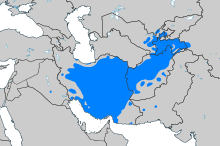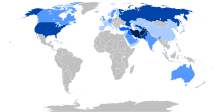New Persian
| New Persian | |
|---|---|
| فارسی نو | |
 Fārsi written in Persian calligraphy (Nastaʿlīq) | |
| Native to |
|
Native speakers | 90 million[7] (110 million total speakers)[6] |
Early forms | |
| Official status | |
Official language in |
|
| Regulated by |
|
| Language codes | |
| ISO 639-1 | fa |
| ISO 639-2 | per (B) fas (T) |
| ISO 639-3 | fas |
| Glottolog | fars1254 |
| Linguasphere | |
 Areas with significant numbers of people whose first language is Persian (including dialects) | |
 Persian Linguasphere. Legend Official language
More than 1,000,000 speakers
Between 500,000 – 1,000,000 speakers
Between 100,000 – 500,000 speakers
Between 25,000 – 100,000 speakers
Fewer than 25,000 speakers / none | |
New Persian (Persian: فارسی نو), also known as Modern Persian (فارسی نوین) and Dari (دری), is the final stage of the Persian language spoken since the 8th to 9th centuries until now in Greater Iran and surroundings. It is conventionally divided into three stages: Early New Persian (8th/9th centuries), Classical Persian (10th–18th centuries), and Contemporary Persian (19th century to present).
Dari is a name given to the New Persian language since the 10th century, widely used in Arabic (compare Al-Estakhri, Al-Muqaddasi and Ibn Hawqal) and Persian texts.[10] Since 1964, it has been the official name in Afghanistan for the Persian spoken there.
Classification[]
New Persian is a member of the Western Iranian group of the Iranian languages, which make up a branch of the Indo-European languages in their Indo-Iranian subdivision. The Western Iranian languages themselves are divided into two subgroups: Southwestern Iranian languages, of which Persian is the most widely spoken, and Northwestern Iranian languages, of which Kurdish is the most widely spoken.[11]
Etymology[]
"New Persian" is the name given to the final stage of development of Persian language. The term Persian is an English derivation of Latin Persiānus, the adjectival form of Persia, itself deriving from Greek Persís (Περσίς),[12] a Hellenized form of Old Persian Pārsa (